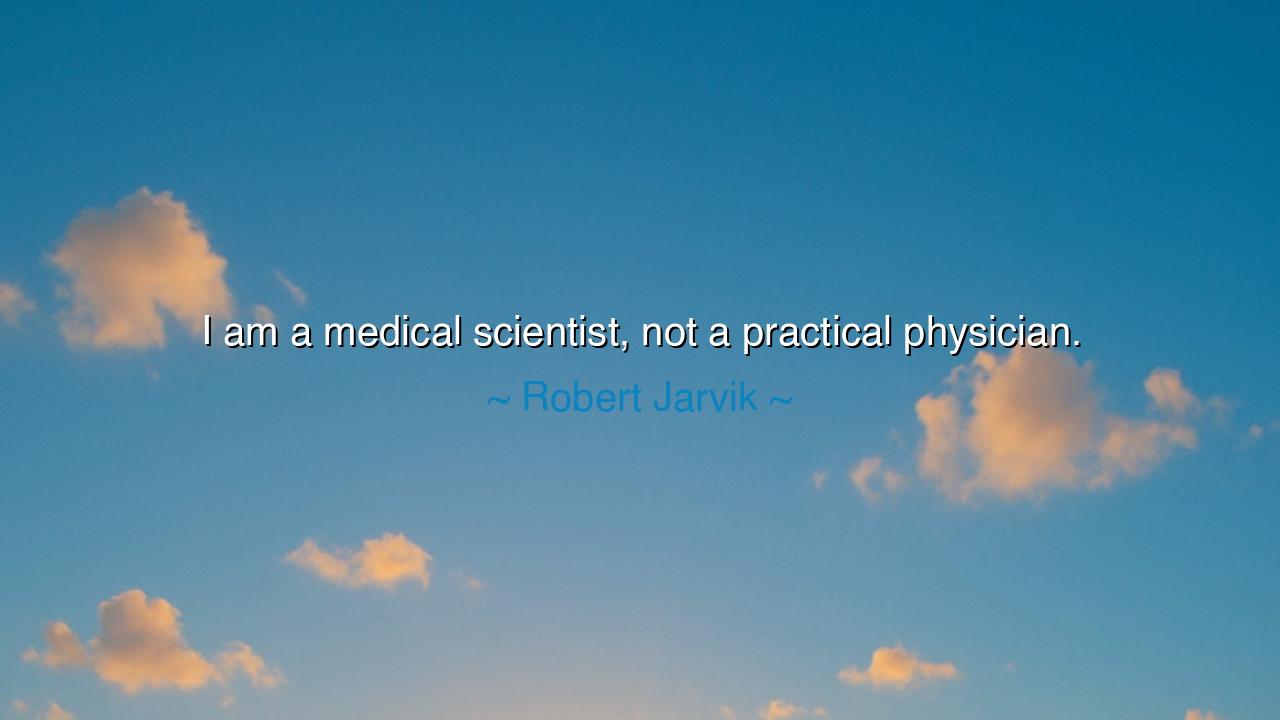
I am a medical scientist, not a practical physician.






Hearken, O seekers of wisdom and architects of discovery, to the words of Robert Jarvik, who declared: “I am a medical scientist, not a practical physician.” Within this statement lies a deep understanding of purpose, specialization, and the many forms of service to humanity. For Jarvik, the calling of science is not bound to the bedside, yet it serves the same noble goal—to preserve and extend life. His words remind us that healing takes many paths: some mend the flesh with their hands, others heal through invention, knowledge, and innovation.
Since the dawn of civilization, the art of healing has walked hand in hand with the pursuit of knowledge. In ancient Egypt, the priests of Imhotep studied both the mystical and the material; in Greece, Hippocrates and Galen observed the body with reverence, bridging philosophy and practice. Yet even then, there was a distinction between those who healed directly and those who sought to understand the hidden laws that governed life itself. Jarvik’s declaration is a modern echo of this ancient division—the recognition that science and practice are twin pillars supporting the temple of medicine.
Robert Jarvik, born into an age of rapid innovation, became a pioneer of the artificial heart, a device that gave breath to those whose bodies had failed. Though not a practicing physician, his intellect and creativity saved countless lives by transforming knowledge into invention. In him, we see the embodiment of his own words: a man who did not hold the scalpel, yet whose work empowered those who did. Like Leonardo da Vinci, who drew the anatomy of man with divine precision without ever practicing medicine, Jarvik’s genius lay in understanding the mechanism of life and reshaping it through reason and design.
His words also carry a humility born of clarity. The medical scientist and the physician are partners in a sacred endeavor. One explores, the other applies; one discovers, the other delivers. The physician’s art is guided by the immediate care of the sick, while the scientist’s calling stretches into the unseen future, where knowledge becomes salvation for generations unborn. Both paths demand discipline, compassion, and purpose—but each serves in a different way. Jarvik reminds us that to know one’s role is itself an act of wisdom.
Consider the story of Alexander Fleming, who discovered penicillin not through deliberate treatment but through curiosity and observation. Fleming was not tending to a patient when he made his discovery; he was studying mold under a microscope. Yet from that quiet act of science arose a revolution in medicine that saved millions of lives. His example, like Jarvik’s, shows that healing is not confined to the clinic—it also dwells in the laboratory, the library, and the restless human mind.
The lesson is profound: the healer’s spirit manifests in many forms. Some give comfort through touch, others through discovery; some work in silence while others labor in the public eye. The medical scientist seeks truth where others see mystery, unraveling nature’s secrets so that humanity may live more fully. The practical physician transforms those truths into mercy and action. Together they form a living chain, each link dependent on the other, united by the single purpose of relieving suffering and preserving life.
Practical action flows from this wisdom: honor every path that contributes to the greater good. Whether you work with hands, with mind, or with heart, know that each role in service to humanity is sacred. Be not ashamed if your gifts lie in inquiry rather than direct action; the thinker, too, is a healer, for ideas are the seeds from which all remedies grow. Pursue excellence in your calling, and let your work—whether of science or service—stand as an offering to the enduring spirit of compassion.
O seeker of understanding, remember this: the title matters not, but the purpose does. Robert Jarvik’s words teach that to serve humanity is not confined to the realm of practice; the pursuit of knowledge itself is an act of mercy. In every experiment, every discovery, every moment of reflection, the true physician-scientist honors life and the boundless potential of the human mind. Thus, wisdom and compassion join hands, and the spirit of healing lives eternal.






AAdministratorAdministrator
Welcome, honored guests. Please leave a comment, we will respond soon